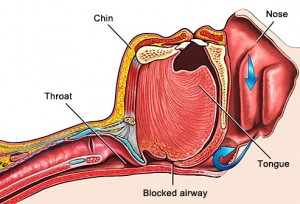The Recovery Position – Left or Right Side?
The recovery position is used to protect an unconscious person’s airway. It involves rolling the casualty onto their side with the head tilted back – but should it be the left or right side?
This is a common question asked on first aid & CPR courses by candidates. There are also lots of different explanations about which side is “better”.
Before we consider this question, let’s remind ourselves of how the recovery position works.
How the Recovery Position Works?
The recovery position works by protecting the casualty’s airway. An unconscious patient will be unable to protect their airway due to loss of muscle tone resulting in the tongue blocking the airway as shown in the diagram below.
In addition, the recovery position protects against aspiration (“inhalation”) of stomach contents. By placing the casualty on their side, any stomach contents will drain away from the airway.
So Which Side is Better?
Short answer – it doesn’t matter which side you roll a patient onto!
Your main priority with the recovery position is to save life and maintain a patent airway. This is the absolute priority and should take precedent over other actions. Do not waste unnecessary time deciding which side might be better to roll them onto.
There is one main exception to this rule. In an unconscious casualty who is heavily pregnant you should attempt to roll them onto their left side. This prevents the baby from compressing one of the main blood vessels in the abdomen.
When to Put Someone in the Recovery Position?
The recovery position is required whenever someone is in a condition that makes them unconscious and when their breathing is weak. Examples of this include:
- Fainting
- Poisoning
- Asphyxia
- Shock
- Heart attack
- Stroke
- Seizure/epilepsy
- Diabetic coma
- Hypothermia
How to Put Someone into the Recovery Position?
Here is how you can put someone in the recovery position:
- Kneel next to the patient or victim.
- Straighten the person’s legs and arms.
- Place the arm that is closest to you over the person’s chest and place the other arm at a right angle to their body.
- Reach for the leg that’s the closest to you and bend the person’s knee.
- Gently take the person’s bent knee and roll them away from you while also supporting their neck and head.
- Adjust the victim’s upper knee in a way such that their knee and hip are both bent at right angles. Make sure they are steady and can’t roll.
- Tilt the person’s head back and ensure that their airways are open and clear.
Infant Recovery Position
In order to put an infant in the recovery position, follow these steps:
- Pick up the infant and cradle them in your arms.
- Position them in a way such that their head is angled downwards and tilted back so that they don’t end up inhaling vomit or choking.
- While supporting the infant’s head, make sure you don’t block their nose and mouth. Keep a check of where your fingers are positioned and check again if the infant can breathe.






As a paramedic, I see first aid being taught in so many ways. We train the same way at Perth Training Institute in that the focus of the recovery position is to have the patient on their side to protect their airway. Whether you roll them away or towards you to meet the objective, the outcome of having them on their side is the focus.